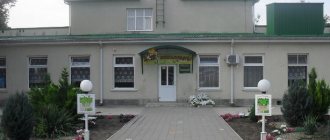Design and research work “Paper: history, properties, types, application and production.”
The technological flow chart for paper production consists of several processes. All stages of papermaking production are carried out on high-performance machines.
1. Preparation of paper pulp (grinding and mixing components, sizing, filling and coloring of paper pulp).
The production of cellulose involves mechanical processing of wood and then chemical reactions with sawdust.
Grinding and mixing.
Coniferous trees are ground into fine sawdust. These sawdust are placed in a boiling solution containing NaHSO4 (sodium hydrogen sulfide) and SO2 (sulfur dioxide). Boiling is carried out at high pressure for many hours. In this case, a chemical reaction occurs in the solution, as a result of which the substance hemicellulose and the substance lignin (a mixture of aromatic hydrocarbons) are obtained, as well as the main reaction product - pure cellulose, which precipitates.
Next, the sediment is crushed using rolls, resulting in cellulose particles of about 1 mm. And when such particles get into water, they immediately swell and form a suspension of cellulose fibers in water - a dark brown pulp. Subsequently, this pulp is bleached.
To make the paper suitable for writing and give it hydrophobic properties, bleached and crushed kaolin, glue, and tint are introduced into the paper pulp and everything is mixed in the required proportions.
Sizing.
The purpose of sizing is to give paper or cardboard
limited absorbent properties in relation to water, ink, printing ink and other liquids and improvement of many other physical and mechanical properties.
Hydrophobic (water-repellent) substances are used for sizing. This can be starch, animal glue, rosin extracted from the resin of coniferous trees, or a special ready-made glue. These substances envelop cellulose fibers, which gives them moisture resistance and mechanical strength.
Filling
is the introduction of mineral filler substances into the paper composition to improve its quality and economic performance. This has the following goals: reducing the cost of paper, increasing its whiteness, increasing the smoothness of the paper surface, reducing opacity, increasing softness and ductility, reducing bulk density, porosity and, consequently, the absorption of printing inks, etc.
One of the oldest fillers is kaolin - an earthy mass similar in composition to clays or talc - a compound from the silicate class. CaCO3 chalk (calcium carbonate) is used as a filler to improve printing properties, to increase the whiteness, smoothness, softness and opacity of paper, which is why such papers are called coated. To increase the wet strength of paper, urea and melamine-formaldehyde resins are added. Titanium dioxide TiO2 is used in the production of coated papers. Zinc oxide ZnO is used as a filler for special types of paper.
Project 'Paper in the life of a modern person'
Project topic:
"Paper in the life of a modern person"
Object of study: paper
Relevance: we have stopped appreciating and taking care of such a necessary thing as paper. Every year the demand for paper increases, and wood reserves decrease. The forest needs to be saved today.
Purpose of the work: to find out how much paper people use in modern life
Tasks:
- 1. Research in what areas of life a person uses paper;
- 2. Identify the need for paper in the everyday life of a modern person;
- 3. Research the topic of the invention of paper;
- 4. Understand the technology of its production;
- 5. Decide how the preservation of the forest is interconnected by caring for paper;
- 6. Improve the ability to work with information, analyze it, form your own opinions, judgments, and conclusions.
- 7. Learn to present the received material in electronic form.
We assumed that in modern life people have begun to use paper less, as they prefer to use the Internet and e-books. At the same time, we noticed that in our class a whole bag of paper waste accumulates in one day. And on Wednesday and Friday, when we have art and technology lessons, much more paper waste accumulates. So we still use paper, and we need it? Then why do we use it so irrationally and wastefully? Why is so much paper going to waste? We decided to look into this problem.
While working on the project, we set ourselves the following goals:
- How much paper do people use in modern life?
To achieve the goal we:
- 1. Researched in what areas of life a person uses paper;
- 2. We identified the need for paper in the daily life of a modern person;
- 3. We studied the topic of the invention of paper and production technology;
- 4. We tried to decide how the preservation of the forest is interconnected with respect for paper.
In our life there are things, objects that we use every day, without which our life is unthinkable. But in the hustle and bustle of life, we often forget about the significance of such things, we stop appreciating and taking care of them.
In the age of computer technology, when all information is stored electronically, on digital media, does a modern person use paper? Imagine yourself, modern man really uses paper and in huge quantities. We will try to convince of the need for paper in the life of a modern person.
All documents, including our very first document, the birth certificate, are made on paper. Everyone will agree that a person cannot live without documents. Further, the person can neither speak nor sit, but the first books are already being read to him, he becomes acquainted with his first authors. After a few months, he begins to look at colorful pictures in books. Then they will buy him his first album, in which he will make his first masterpiece. And there is kindergarten and school ahead, and they buy him huge quantities of notebooks, albums, notepads, cardboard, colored and writing paper. After all, without this, a child cannot learn.
Perhaps we only need paper products when we study. Nothing like this! Almost every day we use newspapers, magazines, textbooks, and teaching aids. All this is made of paper. And some still prefer to read real books rather than electronic ones. And this is also paper. Of course, there are people in the modern world who prefer to read e-books and use the Internet, but even in this case we still use paper. Cash register receipts in a store, tickets on public transport, tickets to the theater, cinema, exhibitions, and museums are made on paper. Even banknotes are made on special paper. In addition, paper serves as packaging material for many products. These include food and medicine, stationery and electronic equipment, shoes and clothing, dishes and furniture, toys and household appliances, gift wrapping paper and gift bags and much more. Each of us uses these products every day, and so we use paper. Paper is used for example in the construction industry. This is primarily wallpaper, which is made on a paper basis.
Postal products are made of paper, such as envelopes, stamps, postcards, calendars, boxes for parcels and parcels. Advertising has entered our lives. Advertising booklets, product catalogs, and other promotional products are also printed on paper.
And lastly, for the skeptics who will say that they use online stores and pay using non-cash means, we left hygiene products, which are also made of paper, and which every person uses every day. No one will deny that he uses toilet paper, napkins, paper handkerchiefs, and paper napkins every day.
Thus, having examined various spheres of human life, we were convinced that modern people use paper products every day. This is very convenient, in many ways it makes our life more comfortable and convenient.
The value of paper lies not only in its necessity in human life, but also in the fact that paper is an environmentally friendly material. The process of recycling paper in nature ranges from a few minutes to several months, depending on the type and density of the paper. Thus, by using paper rather than synthetic materials, we do not pollute the environment, since nature is able to independently recycle paper waste.
While working on the project, we will convince you of the benefits, importance and necessity of paper in our lives.
Even in ancient times, a person had a need for material on which to write. While accumulating life experience, a person understood that it needed to be passed on to the next generations. Therefore, people were looking for material that would serve as a store of information. At first, people wrote on stones, on clay plates, on wooden tablets, on leather, on birch bark. Paper was invented in China in the 2nd century AD. Everyone knows that paper is made from wood. But it was not always so. Initially, paper was made from bamboo fibers, stems of some herbs and old rags. For many years, the process of making paper was kept in the strictest confidence and was known only in the East. It was only in 704 that the process of making paper came to Europe.
The first paper mill appeared in Russia in 1564. The process of making paper is labor-intensive and time-consuming. It will take dozens of years for a forest to grow suitable for paper production. To produce paper in a modern paper mill, a small grove of trees must be cut down every day. Then the bark is peeled off the logs and crushed into chips. The chips are sorted by size on special sieves and sent for cooking. The wood is boiled in special machines to which acid is added. Then the resulting mass is bleached, crushed into fibers and sent to the papermaking workshop. Substances are added to paper raw materials; their presence in writing paper repels moisture. After this, the paper is dyed in a mixer, where dyes and pigments are added. The slurry is poured onto the mesh of the paper machine. The formation of paper fiber begins in the mesh section. This occurs by removing water from the fibrous material. After which the raw paper tape passes through a series of rollers. Some rollers squeeze out the water, others, heated by steam, dry it, others polish it, and finally the finished paper is wound into huge rolls. Thus, moving from machine to machine, wood turns into paper.
You have seen that the paper production process requires a lot of resources and human labor. This production requires a lot of electricity and water. And most importantly, the raw materials for making paper are living trees. We encourage everyone to take care of paper, use it sparingly, and not throw it away needlessly. In addition, there are collection points for waste paper (used paper), which is recycled and used to make paper again. By using paper sparingly, we thus protect the forest. And as you know, forests are our wealth, they are the green lungs of our planet.
While working on the project, we came to the conclusion that people in modern life use paper every day in all sectors of life. The demand for paper increases, accordingly, wood reserves decrease, and the number of forests decreases. We came to the conclusion that we need to be careful with paper. Thus, we will save forests from deforestation and the atmosphere from pollution.
We have continued our research in this direction and are currently working on the project “How to use paper sparingly.”
Research work “The benefits of paper in our lives”
Slide 1
The benefits of paper in our life. Research work of Makarova Alena 4 “B” class MBOU gymnasium No. 1 Supervisor: Yakovleva Larisa Yurievna
Slide 2
I love to draw, paint, and make various applications. At school we write in notebooks and record homework in a diary. The teacher puts grades in the class journal! Modern man cannot imagine himself without paper! Sometimes we don’t even think about how much we spend endlessly!
Slide 3
STOP! IMAGINE IT IS NOT. WHAT TO DO? IT'S SCARY TO EVEN THINK! -What does paper mean? -who invented it? -who invented it and from what, how was it made before and how is it produced now? -How great is its benefit in our lives?
Slide 4
Topic: “The benefits of paper in our lives.”
Slide 5
Purpose of the work: to find out the benefits of paper in our lives. Hypothesis: paper has various properties that people use in industry, medicine, and in everyday life. Object of study: various types of paper. Relevance of the topic: everyone needs paper. Practical significance: the results of my work can be useful in the lessons of fine arts, technology, and the surrounding world.
Slide 6
Research methods: method of analyzing literature on the topic of work; experimental method; sociological survey with
Slide 7
What do I know about paper? I believe that paper is a material for printing and also for other purposes. Most of the home furnishings are paper related.
Slide 8
Meaning of the word "paper". Paper (from Italian bambagia - cotton) is a material consisting of specially processed small plant fibers, closely intertwined and forming a thin sheet.
Slide 9
History of paper as a writing material. Paper did not always exist. A variety of things served as writing materials: drawings on cave walls, clay tablets, papyrus, parchment. Paper was invented by Cai Lun in China 2000 years ago. He found a way to make paper from the fibrous inner bark of the mulberry tree. Gradually, the art of making paper spread throughout the world.
Slide 10
How is paper made? The lumberjacks cut down the tree, divided it into parts on a machine, chopped the logs into chips, and boiled them in a solution for a long time. And then all the liquid is squeezed out, ironed with a roller, dried, ironed. This is how a blank sheet of paper comes out for a magazine, book and notebook.
Slide 13
Experiments with paper. Paper properties. Experiment No. 1 Conclusion: paper is afraid of water. All paper items deteriorate when exposed to water. Paper is a fragile material
Slide 14
Experiment No. 2 (with oil)
Slide 15
Experiment No. 3 Invisible ink.
Slide 16
The letters became visible when the paper was heated. Invisible ink for secret correspondence was used in ancient times
Slide 17
Games with paper. Paper crafts.
Slide 20
Results of my sociological survey: 29 people took part in the survey. The guys don't know much about paper and its use. Before working on the project, I also knew little interesting about such a common material as paper. Now I have learned a lot of interesting things about her.
Slide 21
Interesting facts about paper. -350 million tons of paper are produced worldwide every year. — 25 kg of paper per year is used by the average resident of Russia. “It turns out that cutting yourself with paper is as easy as shelling pears, because a sheet of paper is no thicker than a razor blade—only 100 micromillimeters.” -Paper has the same energy value as potatoes! -500 thousand tons of paper waste are generated in Moscow alone in one year. -Catherine II 240 years ago thought and decided that paper could be used in monetary relations. It was then, by decree of the empress, that the first paper money appeared.
Slide 22
Conclusion Paper occupies an exceptional place in people's lives. Its discovery, like the invention of the wheel, is a miracle, one of the greatest conquests of the human mind. During the project work, I performed many experiments with paper and made a variety of crafts. As a result, I saw that the paper: crumples, tears, curls, cuts, etc. But this is only a small part of what paper is capable of. . Paper accompanies a person throughout his life. The conclusion is obvious: no other material or device (computer, etc.) can replace paper. Having appeared once, paper firmly established itself on Earth and, without knowing any competitors, continues victoriously through the centuries. The benefits of paper are multifaceted.
Slide 23
Enterprises in our region are known for the production of newsprint, plywood, furniture, etc. In the city of Lipetsk, the Solnyshko enterprise produces napkins and toilet paper, PTK Victoria LLC produces products from corrugated cardboard. The Bumiz company in our city is engaged in cutting paper, paper bags, bags, sacks, etc. In the Lipetsk region there are six printed publications, for example in Lipetsk there is a printing house “Positive-L” for the printing and production of books and magazines.
Slide 24
But in order to have beautiful textbooks, notebooks, interesting books, magazines and other items made of paper on the table, you need to save it, because it takes 17 trees to produce one ton of paper. Saving paper is directly related to preserving our forests and beautiful trees. Let's be careful and economical with everything related to paper! Paper will continue to serve humanity in one capacity or another for a long time, but on the condition that people take care of natural resources!






